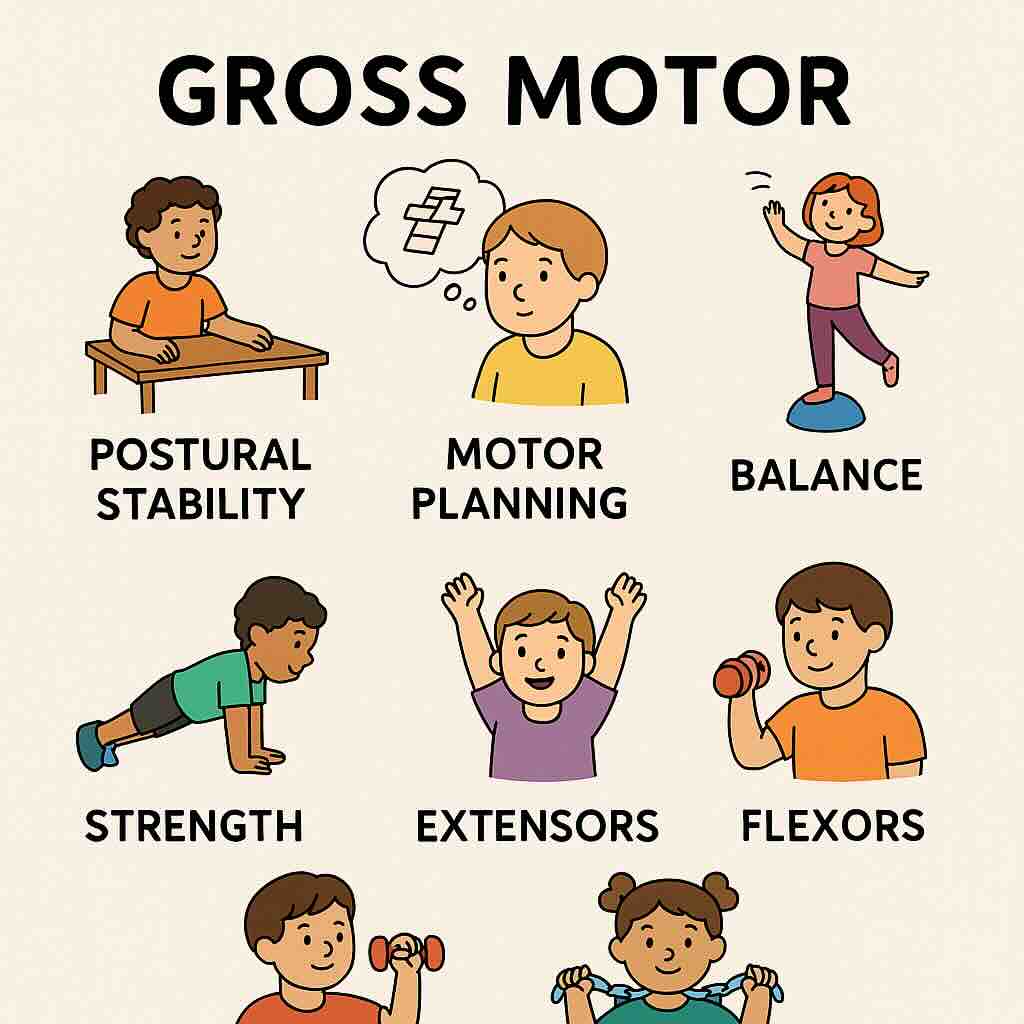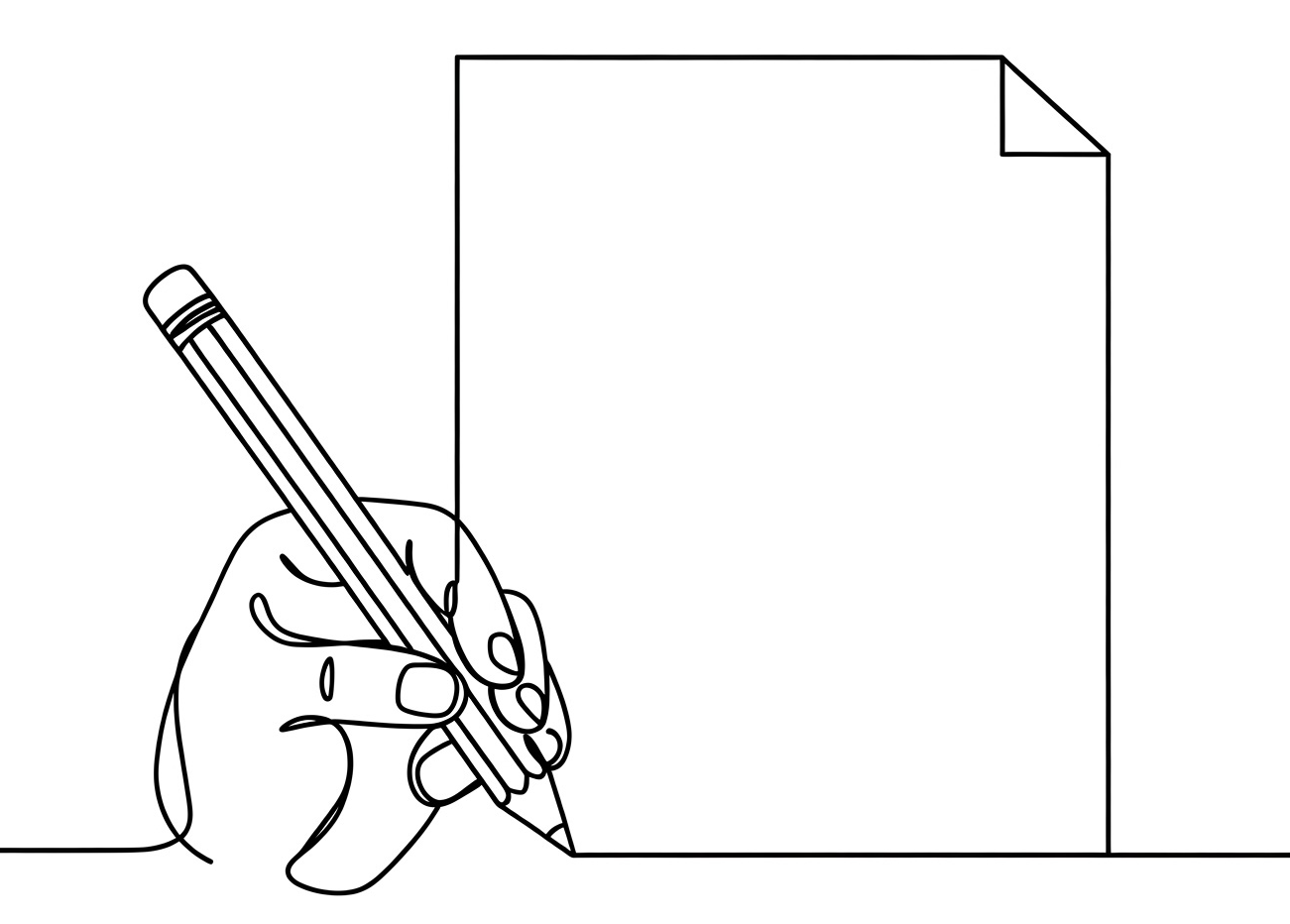Gross motor skills are the large movements we use to sit, stand, walk, run, and control our bodies. These skills build the foundation for more precise movements like writing. When gross motor skills are weak, a child may struggle to stay upright, focus on tasks, or use their hands properly.
Here’s how each gross motor subskill affects handwriting:

Postural Stability
- What it means: Holding your body upright while sitting or standing without slumping.
- How it affects handwriting: Kids who have trouble sitting up may lean on their desk, use their non-writing hand to prop themselves, or fidget constantly. This takes focus away from writing and makes it harder to use their hands properly.
Motor Planning
- What it means: Knowing how to move your body to do a task, and carrying out the steps in the right order.
- How it affects handwriting: A child might not know how to get started or may form letters inconsistently. They may seem clumsy, make more errors, or take a long time to get settled into a writing task.
Endurance
- What it means: The ability to keep your body working without getting tired.
- How it affects handwriting: A child may begin with neat handwriting but lose quality after a short time. They may tire quickly and complain of being “too tired†to finish writing assignments.
Balance
- What it means: Staying steady while sitting, standing, or moving.
- How it affects handwriting: Poor balance can make it hard for a child to sit still. They might wiggle, lean, or frequently change positions, which interrupts focus and fine motor control.
Strength
- What it means: Having enough muscle power to support posture and movement.
- How it affects handwriting: Weak muscles—especially in the core, shoulders, or arms—can make it hard to sit upright or hold the arm steady during writing. The child may use a lot of effort just to stay upright, leaving less energy for writing.
Extensors (Prone Extension)
- What it means: The muscles that straighten the body and help with upright posture.
- How it affects handwriting: Weak extensor muscles can lead to slumping over the desk, resting the head in the hands, or laying on the table—making it hard to use hands freely or write comfortably.
- Prone extension norms:
| Age in years | Position Held (seconds) |
| 4 | 18.5 |
| 6 | 28.93 |
| 8 | >30 seconds |
Reference: Marsha B Lefkof. Trunk Flexion in Healthy Children Aged 3 to 7 Years. PHYS THER January 1986 66:39-44
Flexors (Supine Flexion)
- What it means: The muscles that help bend the body, especially at the hips and arms.
- How it affects handwriting: Flexor control helps with fine-tuning arm and hand movements. If too tight or too weak, it can affect how the child bends their elbows or grips the pencil.
- Supine Flexion Norms :
| Age | Boys (seconds) | Girls (seconds) |
| 3 | 15.5 | 15.8 |
| 4 | 17 | 20.1 |
| 5 | 27.4 | 29.5 |
| 6-up | >55.4 | >52 |
Reference: Marsha B Lefkof. Trunk Flexion in Healthy Children Aged 3 to 7 Years. PHYS THER January 1986 66:39-44
Muscle Tone
- What it means: The natural tension in muscles when the body is at rest.
- How it affects handwriting:
- Low tone: The child may look floppy, tire quickly, or lean on things constantly.
- High tone: The child may seem stiff, overly tense, or use too much pressure while writing.
- Either can affect how comfortably and effectively a child writes.
| Rating | Tone Level | Description | Examples in Young Children |
| 0 | Hypotonia (Flaccid) | No resistance to passive movement; limb feels heavy and floppy | Child appears “like a rag doll,” slumps in seated positions, unable to maintain upright posture without full support |
| 1 | Low Tone | Decreased resistance to passive movement; limbs feel soft but mobile | Frequently slouches, leans on furniture or adults, tires easily, may W-sit for stability, delayed gross motor coordination |
| 2 | Normal Tone | Appropriate resistance to passive movement; typical muscle response | Sits upright independently, engages in age-appropriate play, transitions between positions smoothly |
| 3 | Mild Hypertonia | Slight increase in resistance; catch and release or minimal resistance at end range | Stiff movements during transitions (e.g., sit to stand), mild toe-walking, awkward running pattern |
| 4 | Moderate Hypertonia | Noticeable increase in tone throughout most of the range of motion | Difficulty bending knees/hips fully, rigidity when dressing, resists changes in body position |
| 5 | Severe Hypertonia | Rigid or stiff muscle tone; high resistance throughout the entire range | Very stiff walking with minimal joint movement, may need assistance with most gross motor transitions (e.g., floor to stand) |

